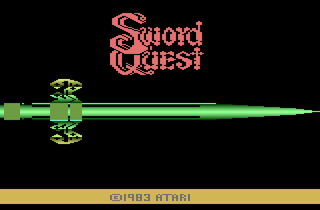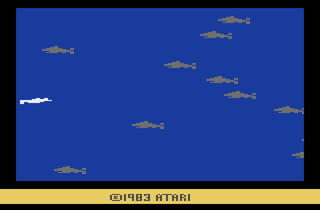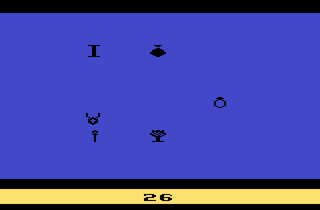

SwordQuest WaterWorld
By Scott Stilphen



WaterWorld is similar to the other 2 games, and is by far the easiest to both play and solve. The cool title screen from EarthWorld is back (although the handle is slightly different) and the game keeps the attract mode from FireWorld. Your character still resembles the one from FireWorld (except it's now white) and the doorway and room coloring is a mix of both previous games.
There are still a total of 16 different objects, but gone are the rope, dagger, water, leather armor, grappling hook, short sword, and food; replacing them are the Crown, king's ring, medallion, money purse, royal seal, scepter, and throne. The ring is now called the peasant's ring, and the oil lamp is called the lamp, but the icon is not the same one used in EarthWorld. There are only 7 rooms and 3 different skill + action tests. You must pass a skill test to gain full access to all the objects in a room (though most can be skipped with the right objects), and now there is a time limit as to when you need to beat it (you can also bypass any test by hitting the fire button, but the same restriction applies). If you pass it, you'll briefly see the sword from EarthWorld's title screen; if you don't, you'll simply see the SwordQuest title screen text. In the Sea of Sharks test, you must swim from the left side of the screen to the right against a steady stream of sharks moving right-to-left. Bumping into any shark puts you back to the left side of the screen. In the School of Octopi test, you must swim from the top of the screen to the bottom past octopi constantly moving back-and-forth horizontally across the screen. It's a bit more challenging since you have to exit through an opening that's centered. The 3rd test, Slippery Ice Floes, is identical to EarthWorld's Rafts of Aquarius but much easier due to the floes not changing speed or shape. Unlike the Rafts, you can move across the bottom before you start jumping, but you can only jump up (no back-tracking). Once you figure out the pattern to reaching the top, the Japanese Geisha-like tune that plays every time you jump will be stuck in your head for all time. Different musical tunes also play every time you enter or leave a room.
Solving this game requires you to place 4 (and only 4) of 7 correct objects in each room. Clues are given to you as you pick up or drop objects in each room. If that wasn't enough help (and it actually is), the game came with a hint booklet, so there's really no excuse for anybody not being able to solve this one. Whether or not this was intentionally made to be easier to solve (perhaps to get more people involved) I don't know, but I know the contest deadline was extended for another 4 months, and they apparently had less correct applicants than for FireWorld. I'm sure most people who were burned by EarthWorld and FireWorld weren't about to buy the same game again. A tune will play while a numerical clue is displayed on your inventory strip at the bottom (sorry, no special graphics screen here). Where the other games allowed you to continue playing and finding more clues, WaterWorld ends every time you find a clue! Again, the Crown object isn't hidden and it would have been nice to play through a single game, uncover all the clues, and receive the Crown as a reward.
By the time WaterWorld reached my local stores, the industry crash was in full swing, and a game that was originally an Atari Age exclusive was now in bargain bins near the end of 1984 for less than $5. Atari's magazine had folded by then, along with just about every other video game magazine, and it was clear the final game in the series, AirWorld, would never be released. Whereas EarthWorld was too hard to solve and FireWorld too frustrating to play, WaterWorld is far too easy to solve. Tod Frye planned on making AirWorld radically different from the other 3, with your character flying (1st-person) on a horse, dodging stuff and picking up items, and selecting 1 of 64 different mini games to play. He had a somewhat-playable prototype working when he was pulled off it to work on another game, and soon after, the SwordQuest project was cancelled. This is something that should have been done with every game in the series - each one should have been radically different, and not the same concept rehashed over and over. In the final analysis, much like his VCS Pac-Man, Frye's SwordQuest concept was an unmitigated disaster and a complete failure.
For more SwordQuest information, check out the SwordQuest Archive of Adventure and SwordQuest Revisted pages.